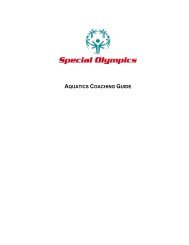Teaching Sport Skills - Special Olympics
Teaching Sport Skills - Special Olympics
Teaching Sport Skills - Special Olympics
You also want an ePaper? Increase the reach of your titles
YUMPU automatically turns print PDFs into web optimized ePapers that Google loves.
<strong>Teaching</strong> Golf <strong>Skills</strong><br />
<strong>Sport</strong> <strong>Skills</strong> Assessment<br />
<strong>Teaching</strong> Golf <strong>Skills</strong><br />
You have now planned your season, trained your instructors, recruited your athletes and have tools to write your lesson<br />
plans. You are now ready to begin the training program for your athletes!<br />
4<br />
1. First you will administer the Golf <strong>Skills</strong> Assessment to determine the ability levels of your athletes.<br />
2. After the assessments, the time for individualization is at hand. In the event that 2 or more Athletes come<br />
through the skills assessment on approximately the same level, they may be grouped together in the same<br />
teaching session which has been individualized to their needs. Keep in the forefront of your mind that this may<br />
be teaching on an individual level and not in a group process. Thus the assessment of the athlete’s achievement<br />
will have to be made for him/her alone. Monitor the athletes’ progress using Daily Performance Records to track<br />
various skills and tasks.<br />
3. Be sure that each teaching session opens with proper warm-up period of 5 – 10 minutes. The instructional period<br />
should be at least 25 – 30 minutes in length. Finis each training session with praise for the achievements made<br />
during the session and anticipation for the next session. A fun time is of importance to your pupils so that they<br />
can approach the next class with eagerness. Establish a personal relationship with each athlete and focus on<br />
their ability, not their disability!<br />
<strong>Sport</strong> <strong>Skills</strong> Assessment<br />
<strong>Sport</strong>s <strong>Skills</strong> Assessment Record Sheets<br />
The levels of instruction include: Physical Assistance (P.A.), Physical Prompt (P.P.), Demonstration (D) Verbal Cue<br />
(VeC) and Visual Cue (ViQ). Physical Assistance means the instructor gives total manual assistance to the athlete for<br />
the entire task. Physical Prompt means the instructor gives partial manual assistance to the athlete for the entire task.<br />
Demonstration involves the instructor demonstrating the entire task for the athlete. A Verbal Cue is a partial verbal<br />
prompt where the instructor uses key words or phrases to elicit motor responses from the athlete. A Visual Cue is a<br />
partial visual prompt where the instructor points at the key elements of the task to elicit motor responses from the<br />
athlete.<br />
Date Mastered<br />
When the athlete performs the task according to the pre-set conditions and criteria, the instructor enters the date the task<br />
was mastered and proceeds to a new task. Once all of the tasks are mastered and the athlete performs the entire skill<br />
upon command and without assistance, the instructor enters that date in the right-hand column, across from the skill<br />
entry.<br />
<strong>Sport</strong>s <strong>Skills</strong> Assessment Record Sheet<br />
Purpose<br />
The <strong>Sport</strong>s <strong>Skills</strong> Assessment Record Sheet is designed for the instructor to record the athlete's pre-assessment and<br />
post-assessment scores. The instructor can use the record sheet as a master list which indicates several things: one, each<br />
athlete's overall development in the program; two, the current ability levels of all the athletes in the program; and three,<br />
comparable progress between athletes in the same ability level, Also, the record sheet is useful for quickly determining<br />
the athlete's placement on sports teams or in future sports skills classes. Together, the <strong>Sport</strong>s <strong>Skills</strong> Assessment Record<br />
Sheet and the Daily Performance Record are effective training devices,<br />
Using the <strong>Sport</strong>s <strong>Skills</strong> Assessment Record Sheet<br />
The instructor tests the athlete with the sports skills assessment before the athlete begins training, and enters the pretraining<br />
assessment score in the proper column on the sheet. After the athlete has trained in the sports skills of that<br />
particular level, the instructor retests the athlete and enters the post-training assessment score in the corresponding<br />
achievement column. Of course, the instructor may allow the athlete to fill in the record sheet so the athlete may see<br />
what progress he/she is making and take pride in his/her achievement.<br />
<strong>Special</strong> <strong>Olympics</strong> Golf Coaching Guide<br />
Created: August 2003

















